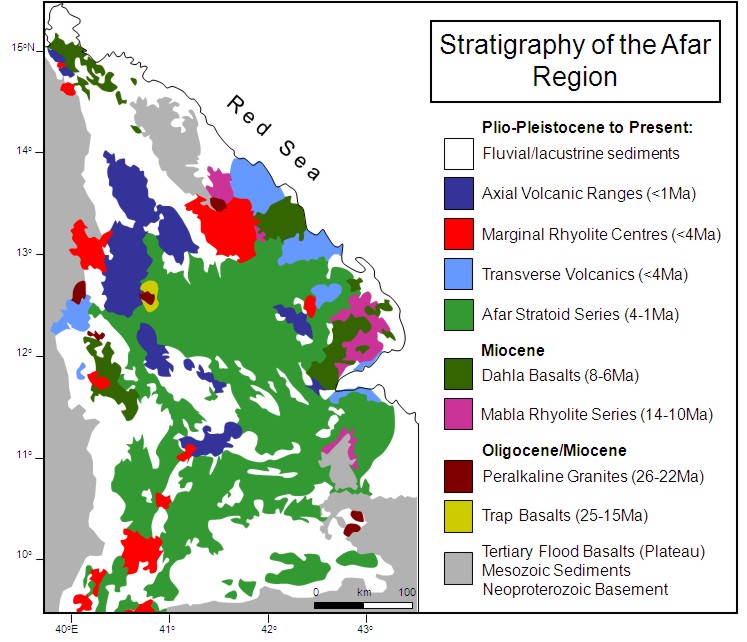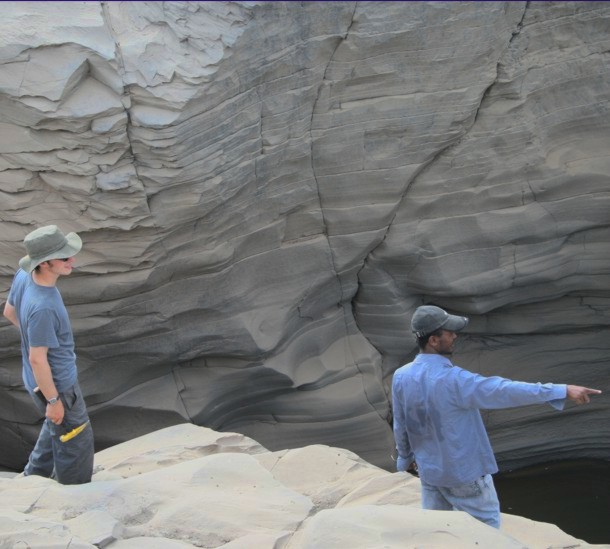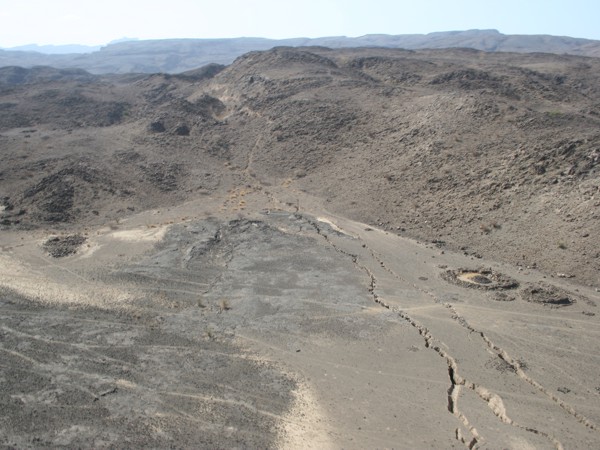
Figure 1: Stratigraphy of the Afar region (after Varet, 1978 and Beyene and Abdelsalam, 2005). Click here for large version.
Stratigraphy of the Afar Region
The oldest basement rocks of the Afar region are a series of volcanic, meta-igneous and meta-sedimentary rocks found at the edge of the Afar Depression, which form part of the Arabian-Nubian Shield. They were accreted when east and west Gondwana collided during the Pan African orogeny in the late Proterozoic, creating a series of north-south to ENE-WSW trending structures and northwest-southeast trending shear zones (eg. Vail, 1985; Stern 94; Abdelsalem & Stern 96). This formed a continuous stable platform until the Permian when intra-continental rifting associated with the break up of Gondwana (rifting between Africa and Madagascar) led to a shallow marine transgression from the Indian Ocean and the deposition of Permian to Palaeogene sedimentary strata on a continental passive margin (Hunegnaw et al, 1998; Schull, 98; Bosellini et al, 01; Wolfenden et al 2005). This was followed by a period of uplift and erosion to a peneplain with laterites (Davidson et al, 1994; Drury et al, 1994).
About 45Ma approximately 1km of basalts topped with rhyolites were emplaced across southwest Ethiopia. These may represent either the initial interaction of the plume with the lithosphere (Ebinger et al, 1993; Ebinger & Sleep, 1998) or relate to a separate plume (George et al, 1998). Between about 42 and 22Ma flood basalts sequences covered much of the region. These are approximately coeval with northeast-directed extension in the southern Red Sea and Gulf of Aden (Baker et al, 1996; Hofman et al, 1997; Ayalew et al, 2002; Uskins et al, 2002; Ayalew & Yirgu, 2003; Coulie et al, 2003).

Gorge through older basalts carved out by flash floods. Photograph by David Pyle, University of Oxford.
The flood sequences peaked between about 31-29Ma with the emplacement of up to 2km of lavas and ignimbrites along the Nubian and Arabian margins of the southern Red Sea (Ebinger et al, 1993; Hofmann et al, 1997; Wolfenden et al 2005). The volcanics are made up repeating sequences of basaltic lava flows overlain by rhyolites including ignimbrites, airfall tuffs and lavas. Silicic volcanics are up to 50% of the preserved thickness and lie towards the top of the sequence. Rhyolitic centres include massive glassy effusive volcanic rocks, phenocryst rich crystalline intrusions which form irregular to dome shaped flows (Ayalew et al, 2006). These Eocene to early Miocene volcanic rocks are found mainly round the edge of the Afar Depression on the Ethiopian and Somalian Plateau. Where they do occur within the Afar Depression (Trap Basalts - 25-15Ma) they are heavily weathered and dissected by faults (Beyene & Abdelsalam, 2005).
The Miocene igneous rocks of the Afar region are divided into the peralkaline granites (26-22Ma), the Trap Basalts (25-15Ma), the Mabla rhyolite series (14-10Ma) and the Dahla series (8-6Ma) (Varet, 1978). There are local variations in the timing and distribution of these series (Wolfenden, 2005). The alkaline to per-alkaline granites are found along the eastern and western edges of the Afar Depression and in the north. They intrude the late Proterozoic basement, the Mesozoic marine sequences and the older volcanic sequences (Varet, 1978). The Trap Basalts are part of the flood basalt sequences. They overlie the Mesozoic sediments and are in places intruded by the peralkaline granites. The Mabla Series erupted from north-south trending vents and consists of rhyolites and ignimbrites with some minor basalt flows (Varet, 1978; Vellutini, 1990). The Dalha Series consists of basaltic fissural flows up to 800m thick with some rare sedimentary rocks and ignimbrites inter-bedded between the flows (Varet, 1978).
The most extensive volcanic sequence covering about two thirds of the Afar Depression is the Pliocene-Pleistocene Afar Stratoid Series. Individual basalt flows are between 1 and 6m thick and the whole Series is up to 1500m thick. It lies non-conformably on the Dalha Series indicating a period of erosion and lowered magmatic activity between the two series (Varet, 1978).

The rift zone to the south of Dabbahu volcano in the Axial Volcanic Ranges. The cracks are in older basalts, softer sedimentary rocks and volcanic ash Photograph by Julie Rowland, University of Auckland.
In the east and west of the Afar Depression are the Tranverse volcanics and Marginal centres. These are east/northeast trending volcanic centres around 4 million years old and are intercalculated with the top of the Afar Stratoid Series. The Transverse volcanics consist of basaltic lava flows with inclusions of peridotite nodules suggesting a mantle source. The Marginal centres are summit calderas with trachytic and rhyolitic sequences (Barberi & Varet, 1975; Barberi & Varet, 1977; Varet 1978).
The Quaternary Axial Volcanic Ranges are characterised by fissure eruptions and shield volcanoes with basaltic flows and alkaline and per-alkaline silicic rocks and occur along northwest-southeast trending narrow rift zones. The Axial Volcanic Ranges are underlain by thin ocean-type crust which youngs from the marginal to the central zones. These similarities with mid-oceanic ridges have led to the idea that the Axial Volcanic Ranges represent oceanic spreading centres (Varet, 1978; Tefera et al, 1996).
The Quaternary sedimentary rocks of the Afar Depression are mainly fluvial/lacustrine with thicknesses up to 200m in places (Varet, 1978).
